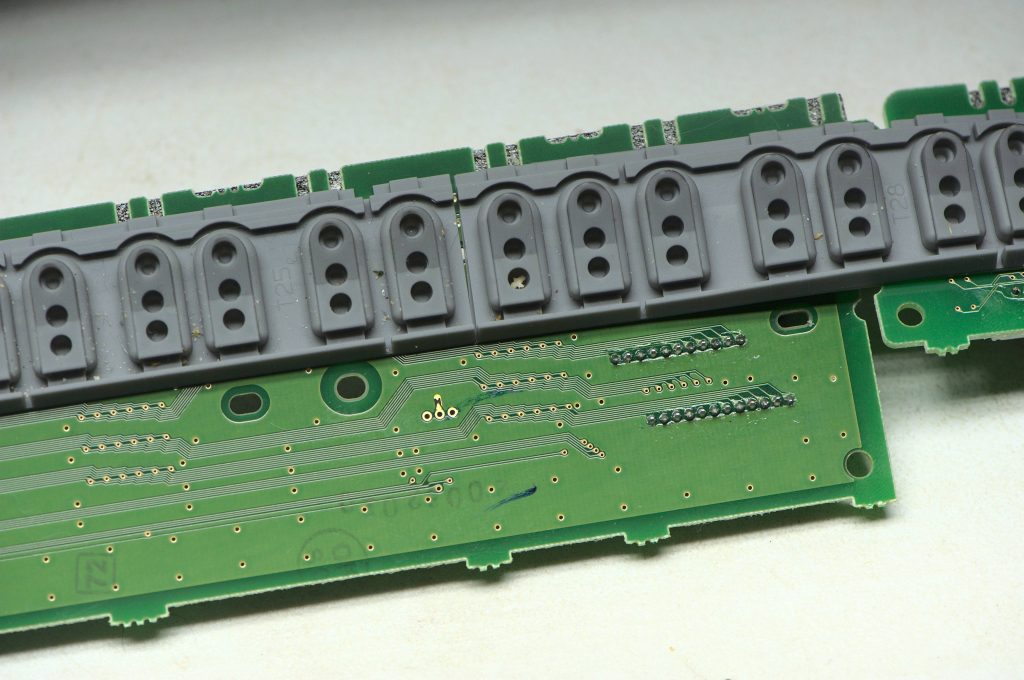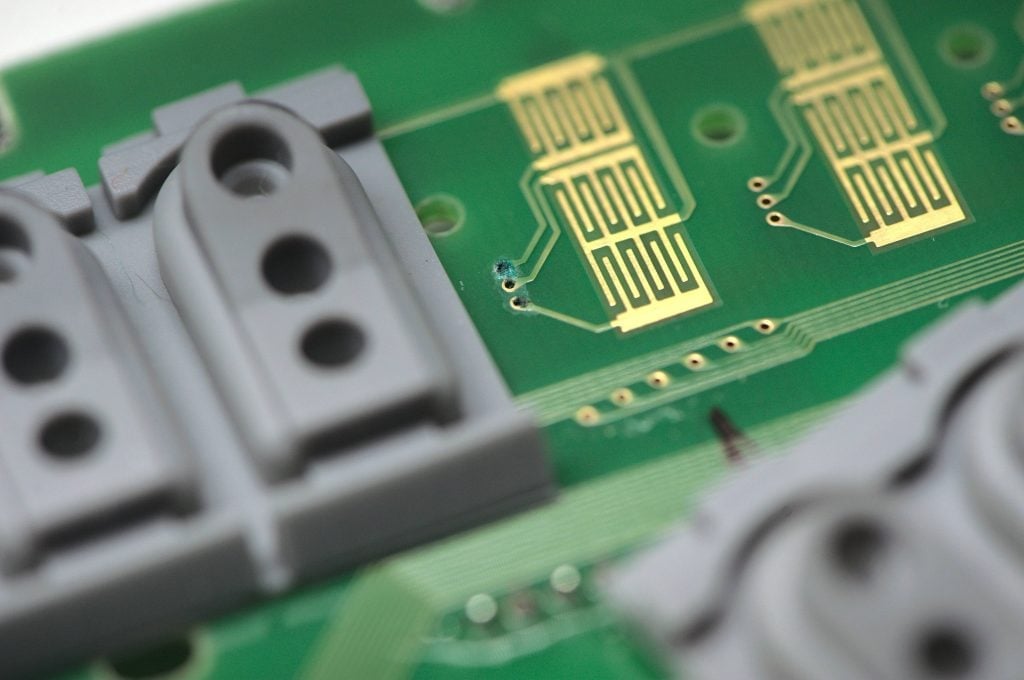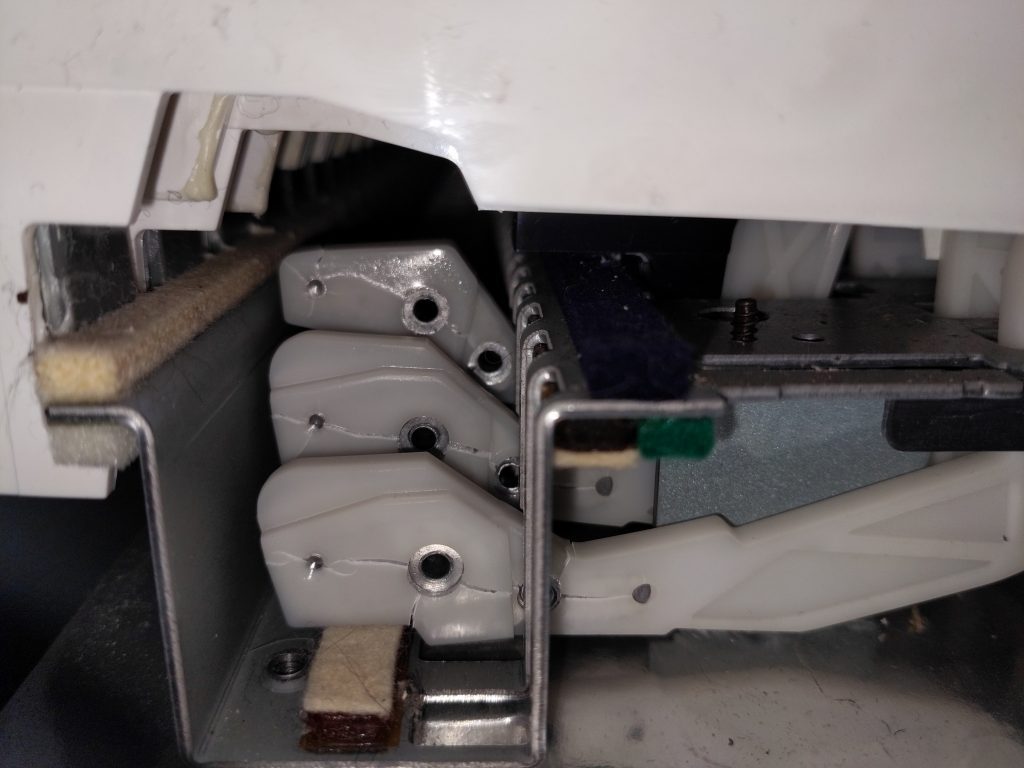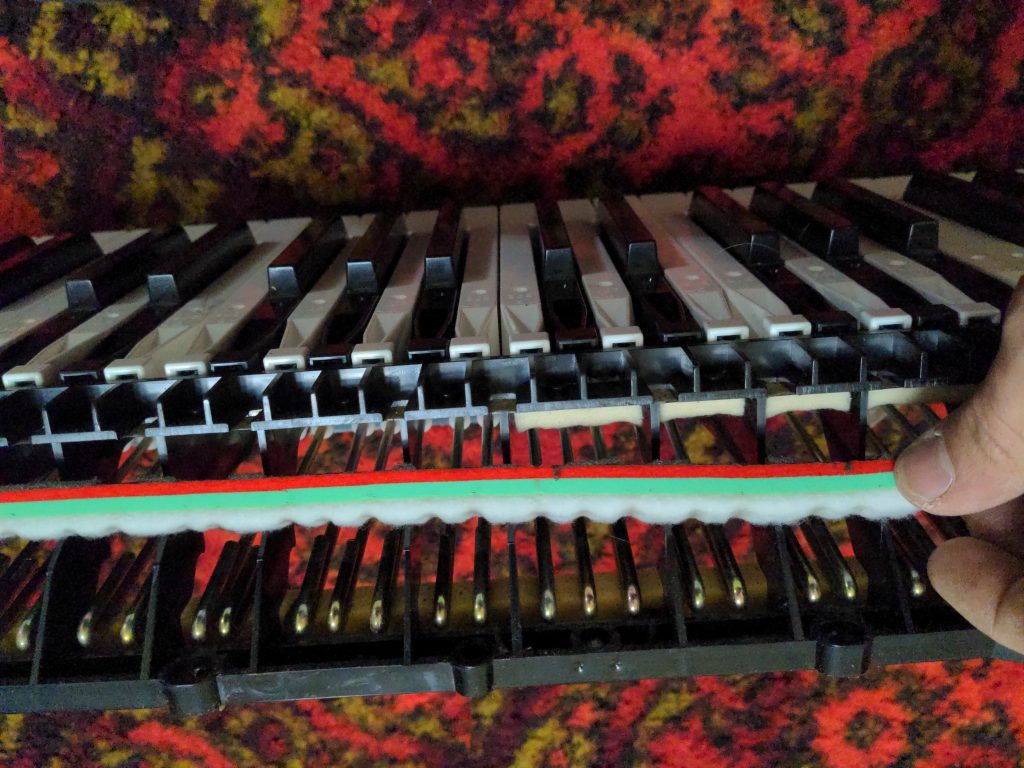One or more keys play at full volume even though I’m hardly pressing them!
Keyboards use very sensitive contacts to determine how fast you’re pressing the key (or the velocity). A keyboard with dirty contacts (such as the one pictured below) will misjudge velocity, and will cause the key to play at incorrect or, often, persistently loud volume. In the case of the picture below, that wood chip would cause a perpetually quiet key—if it moved to the depression directly above it, then it would cause a perpetually loud key. Cleaning is sometimes an effective option.
They can also simply wear out. If you play your keyboard for hours a day, the rubber itself will eventually degrade, as will the graphite pads on the button. In that case, they’ll need to be completely replaced, which is typically possible for keyboards that are less than ten years old, but becomes progressively more difficult with age. Replacement is usually the best option.
In desperate times, if contacts just aren’t available, you can swap contact strips from the ends of the keyboards to replace keys you play more typically. There are products like Oak Tree Vintage’s Key Contact Repair Kit, but I view these as an absolute last resort. Direct rubber contact strip repair is a desperate measure.

One or more keys don’t play at all.
A common cause of silent keys are bad or damaged rubber key contacts. See above. They should be cleaned or replaced.
Another common cause of silent keys is a damaged or corroded key contact printed circuit board (PCB). These PCBs are, for late-model keyboards, typically available—particularly for Yamaha and Roland. They can also sometimes be repaired: In the case of the image below, some cleanup and a wire jumper fixed the problem.

My keyboard doesn’t turn on!
There are many common reasons for this. The most common, in order, are damaged power cords or adapters, a blown fuse, a damaged power inlet (see below), or a damaged power switch. It can also be a sign of an electronics failure somewhere else in the keyboard.
Start by replacing the cord. That’s something fairly inexpensive you can do yourself. Try to find a direct manufacturer replacement. If you require any assistance in this, you can contact me, or you can reach out to a local piano store. In the case of a power cord with an adapter, both the voltage and the polarity have to be correct.
Somebody broke off the power inlet on the back of the keyboard.
This is a common problem. Nearly every pedal inlet for nearly every keyboard is available. I replace them regularly, particularly in schools where the cord might get forcefully pushed or pulled! Depending on the way that it was broken, there might be some collateral damage. For instance, a Roland I repaired recently had the fuse assembly ripped off when the power inlet, acting as a battering ram, scraped the electronics off the rest of the inlet circuit board. However, there’s nothing particularly complicated on there, and their story ends happily!
I’ve got a Yamaha Clavinova and some keys are sticking.
This is a very common issue in Yamaha Clavinovas from the early 2000s. Unfortunately, the tails of the keys would crack, resulting in sluggish behavior. Then they would fully break, causing a sticking key. More than once, I’ve gotten a call after a rowdy child will walk up to the keyboard and spontaneously break a dozen or so keys—it’s not their fault. These keys can be replaced.
I typically don’t recommend doing them one-by-one unless you’re going to be replacing them yourself. It’s much better to replace the entire keyboard assembly or to replace all the keys. This is an expensive repair, but it’s much less expensive than a brand new Clavinova, and if the rest of the electronics are in good shape, it’s worth considering.
If the Yamaha uses a three-sensor keyboard, you might consider upgrading to a natural wood action at the same time. If it uses a two-sensor keyboard, this isn’t an option.
I’ve got a Roland RD-xxx and one or more keys are staying down. They seem loose.
Roland RD keyboards from the 2000s and earlier used plastic hammers that crack and break. Unfortunately, Roland no longer manufactures these hammers. If you have such a keyboard, you’re at the mercy of used parts dealers and eBay. I maintain a small stockpile for customers, but this condition is usually terminal.
This is a very distressing situation for me, so if you have any further information that might assist in fabricating these or are aware of a stockpile of these, please contact me. Currently, single replacements sell up to $100 on eBay.

I’ve got a Yamaha, and it makes a clacking sound when I let go of or hit a key.
Yamaha Clavinovas and portable keyboards have a strike felt and a rest felt. In nearly all cases, rest felts will wear out within a decade. This causes keys will make a clacking sound when released. With heavier use, strike felts can also wear out. Both felts are relatively easy to replace. Both lead to a noisy keyboard.

